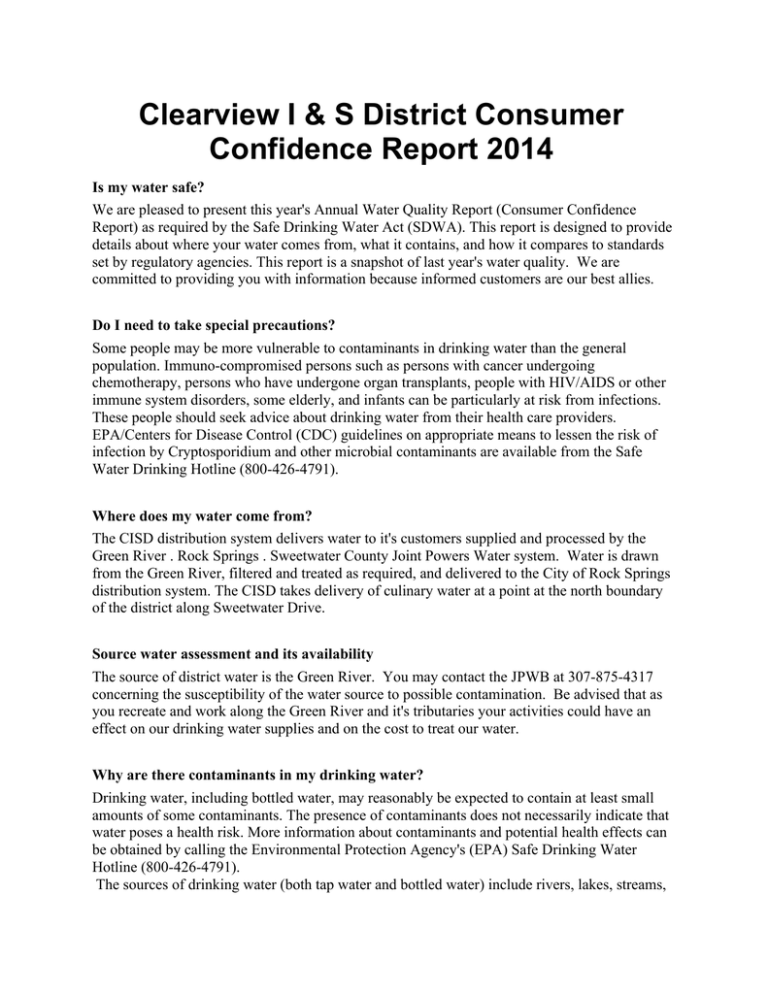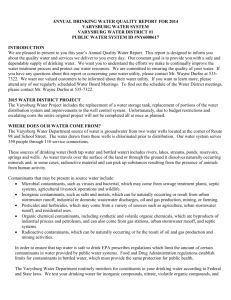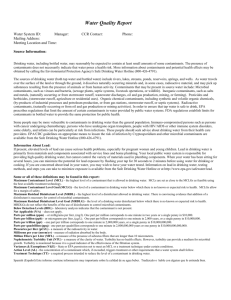Clearview I & S District Consumer Confidence Report 2014
advertisement

Clearview I & S District Consumer Confidence Report 2014 Is my water safe? We are pleased to present this year's Annual Water Quality Report (Consumer Confidence Report) as required by the Safe Drinking Water Act (SDWA). This report is designed to provide details about where your water comes from, what it contains, and how it compares to standards set by regulatory agencies. This report is a snapshot of last year's water quality. We are committed to providing you with information because informed customers are our best allies. Do I need to take special precautions? Some people may be more vulnerable to contaminants in drinking water than the general population. Immuno-compromised persons such as persons with cancer undergoing chemotherapy, persons who have undergone organ transplants, people with HIV/AIDS or other immune system disorders, some elderly, and infants can be particularly at risk from infections. These people should seek advice about drinking water from their health care providers. EPA/Centers for Disease Control (CDC) guidelines on appropriate means to lessen the risk of infection by Cryptosporidium and other microbial contaminants are available from the Safe Water Drinking Hotline (800-426-4791). Where does my water come from? The CISD distribution system delivers water to it's customers supplied and processed by the Green River . Rock Springs . Sweetwater County Joint Powers Water system. Water is drawn from the Green River, filtered and treated as required, and delivered to the City of Rock Springs distribution system. The CISD takes delivery of culinary water at a point at the north boundary of the district along Sweetwater Drive. Source water assessment and its availability The source of district water is the Green River. You may contact the JPWB at 307-875-4317 concerning the susceptibility of the water source to possible contamination. Be advised that as you recreate and work along the Green River and it's tributaries your activities could have an effect on our drinking water supplies and on the cost to treat our water. Why are there contaminants in my drinking water? Drinking water, including bottled water, may reasonably be expected to contain at least small amounts of some contaminants. The presence of contaminants does not necessarily indicate that water poses a health risk. More information about contaminants and potential health effects can be obtained by calling the Environmental Protection Agency's (EPA) Safe Drinking Water Hotline (800-426-4791). The sources of drinking water (both tap water and bottled water) include rivers, lakes, streams, ponds, reservoirs, springs, and wells. As water travels over the surface of the land or through the ground, it dissolves naturally occurring minerals and, in some cases, radioactive material, and can pick up substances resulting from the presence of animals or from human activity: microbial contaminants, such as viruses and bacteria, that may come from sewage treatment plants, septic systems, agricultural livestock operations, and wildlife; inorganic contaminants, such as salts and metals, which can be naturally occurring or result from urban stormwater amounts of some contaminants. The presence of contaminants does not necessarily indicate that water poses a health risk. More information about contaminants and potential health effects can be obtained by calling the Environmental Protection Agency's (EPA) Safe Drinking Water Hotline (800-426-4791). The sources of drinking water (both tap water and bottled water) include rivers, lakes, streams, ponds, reservoirs, springs, and wells. As water travels over the surface of the land or through the ground, it dissolves naturally occurring minerals and, in some cases, radioactive material, and can pick up substances resulting from the presence of animals or from human activity: microbial contaminants, such as viruses and bacteria, that may come from sewage treatment plants, septic systems, agricultural livestock operations, and wildlife; inorganic contaminants, such as salts and metals, which can be naturally occurring or result from urban stormwater runoff, industrial, or domestic wastewater discharges, oil and gas production, mining, or farming; pesticides and herbicides, which may come from a variety of sources such as agriculture, urban stormwater runoff, and residential uses; organic Chemical Contaminants, including synthetic and volatile organic chemicals, which are by-products of industrial processes and petroleum production, and can also come from gas stations, urban stormwater runoff, and septic systems; and radioactive contaminants, which can be naturally occurring or be the result of oil and gas production and mining activities. In order to ensure that tap water is safe to drink, EPA prescribes regulations that limit the amount of certain contaminants in water provided by public water systems. Food and Drug Administration (FDA) regulations establish limits for contaminants in bottled water which must provide the same protection for public health. How can I get involved? Information on the CISD system may be obtained from the CISD office or by attending a regular scheduled meeting of the DISD Board of Directors. Meeting are held on the 2nd Thursday of each month at the District Office, 117 Mountain View Dr. Contact the office at 307 -362-1140 for further information. Information concerning the Green River- Rock Springs - Sweetwater County Joint Powers Water Board and the Consumer Confidence Report published by the JPWB may be obtained by contacting the JPWB at 307-875-4317 or visiting the JPWB office. Monitoring and reporting of compliance data violations The Clearview I&SD had the following major monitoring violations during calendar year 2014: CISD failed to monitor for Total Coliform bacteria for the month of January, 2014. Subsequent samples were satisfactory. The Clearview I&SD had the following minor monitoring violations during calendar year 2014: CISD failed to monitor for Chlorine residuals during the correct month. Subsequent samples were satisfactory. CISD has revised it's monitoring and recordkeeping routine to ensure future compliance. Violations of terms of variance, exemption, or administrative or judicial order Clearview I&SD was in violation of an administrative order issued under the authority of the safe drinking water act. Water monitoring requirements had not been met. The CISD has revised it's monitoring and recordkeeping procedures to ensure compliance with all regulatory requirements. we believe that all regulatory requirements are currently being met. Additional Information for Lead If present, elevated levels of lead can cause serious health problems, especially for pregnant women and young children. Lead in drinking water is primarily from materials and components associated with service lines and home plumbing. Clearview Improvement & Service District is responsible for providing high quality drinking water, but cannot control the variety of materials used in plumbing components. When your water has been sitting for several hours, you can minimize the potential for lead exposure by flushing your tap for 30 seconds to 2 minutes before using water for drinking or cooking. If you are concerned about lead in your water, you may wish to have your water tested. Information on lead in drinking water, testing methods, and steps you can take to minimize exposure is available from the Safe Drinking Water Hotline or at http://www.epa.gov/safewater/lead. Water Quality Data Table In order to ensure that tap water is safe to drink, EPA prescribes regulations which limit the amount of contaminants in water provided by public water systems. The table below lists all of the drinking water contaminants that we detected during the calendar year of this report. Although many more contaminants were tested, only those substances listed below were found in your water. All sources of drinking water contain some naturally occurring contaminants. At low levels, these substances are generally not harmful in our drinking water. Removing all contaminants would be extremely expensive, and in most cases, would not provide increased protection of public health. A few naturally occurring minerals may actually improve the taste of drinking water and have nutritional value at low levels. Unless otherwise noted, the data presented in this table is from testing done in the calendar year of the report. The EPA or the State requires us to monitor for certain contaminants less than once per year because the concentrations of these contaminants do not vary significantly from year to year, or the system is not considered vulnerable to this type of contamination. As such, some of our data, though representative, may be more than one year old. In this table you will find terms and abbreviations that might not be familiar to you. To help you better understand these terms, we have provided the definitions below the table. Contaminants MCLG MCL, or TT, or Your Range Sample MRDLG MRDL Water Low High Date Violation Typical Source Disinfectants & Disinfectant By-Products (There is convincing evidence that addition of a disinfectant is necessary for control of microbial contaminants) Haloacetic Acids By-product of drinking water NA 60 29 NA 2014 No (HAA5) (ppb) chlorination TTHMs [Total By-product of drinking water Trihalomethanes] NA 80 31.2 NA 2014 No disinfection (ppb) Unit Descriptions Term ppb Definition ppb: parts per billion, or micrograms per liter (µg/L) NA NA: not applicable ND ND: Not detected NR NR: Monitoring not required, but recommended. Important Drinking Water Definitions Term Definition MCLG MCL TT AL Variances and Exemptions MRDLG MRDL MNR MPL For more information please contact: Contact Name: Lee Splett, Water Operator Address: PO Box 2634 Rock Springs, WY 82902 Phone: 3073892317 E-Mail: cisd@rocketmail.com MCLG: Maximum Contaminant Level Goal: The level of a contaminant in drinking water below which there is no known or expected risk to health. MCLGs allow for a margin of safety. MCL: Maximum Contaminant Level: The highest level of a contaminant that is allowed in drinking water. MCLs are set as close to the MCLGs as feasible using the best available treatment technology. TT: Treatment Technique: A required process intended to reduce the level of a contaminant in drinking water. AL: Action Level: The concentration of a contaminant which, if exceeded, triggers treatment or other requirements which a water system must follow. Variances and Exemptions: State or EPA permission not to meet an MCL or a treatment technique under certain conditions. MRDLG: Maximum residual disinfection level goal. The level of a drinking water disinfectant below which there is no known or expected risk to health. MRDLGs do not reflect the benefits of the use of disinfectants to control microbial contaminants. MRDL: Maximum residual disinfectant level. The highest level of a disinfectant allowed in drinking water. There is convincing evidence that addition of a disinfectant is necessary for control of microbial contaminants. MNR: Monitored Not Regulated MPL: State Assigned Maximum Permissible Level






